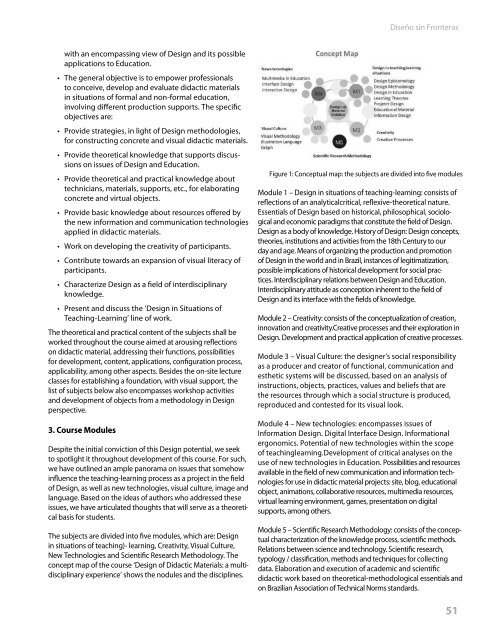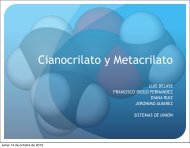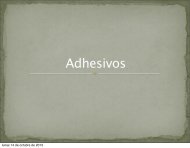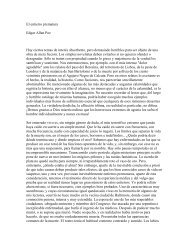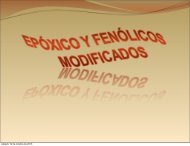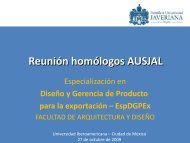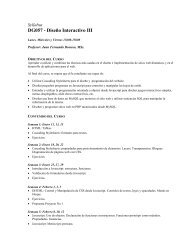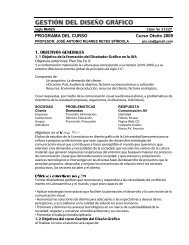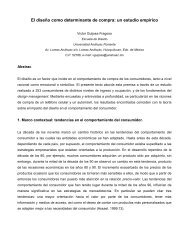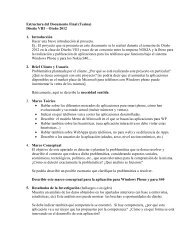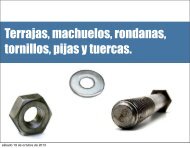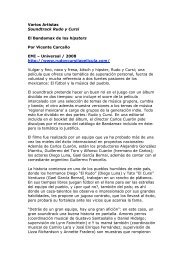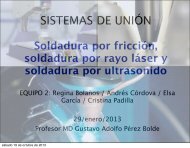Diseño sin Fronteraswith an encompassing view of Design and its possibleapplications to Education. The general objective is to empower professionalsto conceive, <strong>de</strong>velop and evaluate didactic materialsin situations of formal and non-formal education,involving different production supports. The specificobjectives are: Provi<strong>de</strong> strategies, in light of Design methodologies,for constructing concrete and visual didactic materials. Provi<strong>de</strong> theoretical knowledge that supports discussionson issues of Design and Education. Provi<strong>de</strong> theoretical and practical knowledge abouttechnicians, materials, supports, etc., for elaboratingconcrete and virtual objects. Provi<strong>de</strong> basic knowledge about resources offered bythe new information and communication technologiesapplied in didactic materials. Work on <strong>de</strong>veloping the creativity of participants. Contribute towards an expansion of visual literacy ofparticipants. Characterize Design as a field of interdisciplinaryknowledge. Present and discuss the ‘Design in Situations ofTeaching-Learning’ line of work.The theoretical and practical content of the subjects shall beworked throughout the course aimed at arousing reflectionson didactic material, addressing their functions, possibilitiesfor <strong>de</strong>velopment, content, applications, configuration process,applicability, among other aspects. Besi<strong>de</strong>s the on-site lectureclasses for establishing a foundation, with visual support, thelist of subjects below also encompasses workshop activitiesand <strong>de</strong>velopment of objects from a methodology in Designperspective.3. Course ModulesDespite the initial conviction of this Design potential, we seekto spotlight it throughout <strong>de</strong>velopment of this course. For such,we have outlined an ample panorama on issues that somehowinfluence the teaching-learning process as a project in the fieldof Design, as well as new technologies, visual culture, image andlanguage. Based on the i<strong>de</strong>as of authors who addressed theseissues, we have articulated thoughts that will serve as a theoreticalbasis for stu<strong>de</strong>nts.The subjects are divi<strong>de</strong>d into five modules, which are: Designin situations of teaching)- learning, Creativity, Visual Culture,New Technologies and Scientific Research Methodology. Theconcept map of the course ‘Design of Didactic Materials: a multidisciplinaryexperience’ shows the nodules and the disciplines.Figure 1: Conceptual map: the subjects are divi<strong>de</strong>d into five modulesModule 1 – Design in situations of teaching-learning: consists ofreflections of an analyticalcritical, reflexive-theoretical nature.Essentials of Design based on historical, philosophical, sociologicaland economic paradigms that constitute the field of Design.Design as a body of knowledge. History of Design: Design concepts,theories, institutions and activities from the 18th Century to ourday and age. Means of organizing the production and promotionof Design in the world and in Brazil, instances of legitimatization,possible implications of historical <strong>de</strong>velopment for social practices.Interdisciplinary relations between Design and Education.Interdisciplinary attitu<strong>de</strong> as conception inherent to the field ofDesign and its interface with the fields of knowledge.Module 2 – Creativity: consists of the conceptualization of creation,innovation and creativity.Creative processes and their exploration inDesign. Development and practical application of creative processes.Module 3 – Visual Culture: the <strong>de</strong>signer’s social responsibilityas a producer and creator of functional, communication an<strong>de</strong>sthetic systems will be discussed, based on an analysis ofinstructions, objects, practices, values and beliefs that arethe resources through which a social structure is produced,reproduced and contested for its visual look.Module 4 – New technologies: encompasses issues ofInformation Design. Digital Interface Design. Informationalergonomics. Potential of new technologies within the scopeof teachinglearning.Development of critical analyses on theuse of new technologies in Education. Possibilities and resourcesavailable in the field of new communication and information technologiesfor use in didactic material projects: site, blog, educationalobject, animations, collaborative resources, multimedia resources,virtual learning environment, games, presentation on digitalsupports, among others.Module 5 – Scientific Research Methodology: consists of the conceptualcharacterization of the knowledge process, scientific methods.Relations between science and technology. Scientific research,typology / classification, methods and techniques for collectingdata. Elaboration and execution of aca<strong>de</strong>mic and scientificdidactic work based on theoretical-methodological essentials andon Brazilian Association of Technical Norms standards.51
MX Design Conference 2011We can also say that the practice of Design in Teaching-LearningSituations enables <strong>de</strong>signers to <strong>de</strong>al with complex problems.In this particular point, the formation of interdisciplinary teamsis indispensable, since they provi<strong>de</strong> for the creation of efficienteducational artifacts, promoting and sustaining educationalrelations, providing dialogue between the teacher and stu<strong>de</strong>ntin the teaching-learning process.4. Final consi<strong>de</strong>rationsLDBEN, law no. 9.394/96, art. 26, § 2, stipulates that the teachingof art is an obligatory curricular component at the diverse levelsof basic education, promoting the cultural <strong>de</strong>velopment of thestu<strong>de</strong>nts. It will observe the following gui<strong>de</strong>lines: the contentwill be distributed among the various gra<strong>de</strong>s and levels of basiceducation by the schools, and it will obligatorily encompass: a)music, theater and dance; b) visual arts and <strong>de</strong>sign; c) artistic,cultural and architectural heritage (Brazil, 2009).The course being offered can also enable the offer of contentrelated to visual literacy as complementary education. Studieshave shown that for people to be taught visual literacy, they needto un<strong>de</strong>rgo a methodological visual experience that inclu<strong>de</strong>sexplorations, analyses and <strong>de</strong>finition with the objective of enablingan increase in their capacity to un<strong>de</strong>rstand the visual experience.This should find a place of reference within the heart of the school.This is a theme of recent interest in the school environmentand is lacking in practical and theoretical collaborations.It brings new <strong>de</strong>mands in relation to the formation ofteachers in the diverse languages mentioned. Design, asan area related to visual culture, can be part of this experience.This thus presents the union of three pillars: Design,Visual Culture and Technology, as the three conditionsof knowledge that come from society for education andpresent by <strong>de</strong>fault of formative intellectual processes.ReferencesBRASIL. Lei <strong>de</strong> Diretrizes e Bases da Educação Nacional: Lei no9.394, <strong>de</strong> 20 <strong>de</strong> <strong>de</strong>zembro <strong>de</strong> 1996. Brasília, 1996. Disponívelem: .BONSIEPE, G. Design, Cultura e Socieda<strong>de</strong>. São Paulo: Blucther,2011.BUXTON, B. Sketching User Experiences: Getting the DesignRight and the Right Design. São Francisco: MorganKaufman, 2007.Luiz Antonio L. (org.). Conceitos-chave em <strong>de</strong>sign. Rio <strong>de</strong>Janeiro: Ed. PUC-Rio: Novas Idéias, 2008.COUTO, R. M. Escritos sobre Ensino <strong>de</strong> Design no Brasil. 1. ed.Rio <strong>de</strong> Janeiro: Rio Book’s, 2008. v. 1. 96 p.DONDIS. D. A. Sintaxe da linguagem visual. São Paulo: MartinsFonseca, 2003.ENGELHARDT, Y. The language of graphics: a framework forthe analysis of the syntax and meaning in maps, charts anddiagrams. Amsterdã: illc-publications, 2002.FONTOURA, A. M. EDADE – Educação <strong>de</strong> crianças e jovensatravés do <strong>de</strong>sign. Tese (Doutorado em Engenharia daProdução) – Programa <strong>de</strong> Pós-Graduação em Engenharia daProdução, UFSC, 2002, 337 p.FUENTES, R. A Prática do <strong>de</strong>sign gráfico. Uma metodologiacriativa. São Paulo: Edições Rosari, 2006.LUPTON, E; MILLER J. A. ABC da Bauhaus. São Paulo: Cosac Naify,2010.MANZINI, E. V. C. O <strong>de</strong>senvolvimento <strong>de</strong> produtos sustentáveis:os requisitos ambientais dos produtos industriais. São Paulo:EDUSP, 2002.MEGGS, Phillip. História do <strong>de</strong>sign gráfico. São Paulo. CosacNaify, 2009.MOGGRIDGE, B. Design ing Interection, s. Cambridge: MIT Press,2007MORVILLE, P. Ambient findability. O´Reilly, 2005.MORAN J. M, MASETTO M, BEHRENS M. Novas tecnologias emediação pedagógica. 7ª ed. São Paulo: Papirus; 2003.PORTUGAL, C.; COUTO, R. M. S. Design in Situations of Teachingand Leering a case study. In: EDULEARN10 - InternationalConference on Education and New Learning Technologies.Barcelona, 2010.STRAUB, Ericson; CASTILHO, Marcelo. Conexões: como os<strong>de</strong>signers conectam experiência, intuição e processo emseus projetos. São Paulo: Infolio. 2010.SHEDROFF, N. Information interaction Design: a unified fieldtheory of Design. Disponível em: .SPENCE, R. Information Visualization: Design for Interection, .New Jersey: Prentice Hall, 2007.SUDIJC, Deyan. Linguagem das coisas. Rio <strong>de</strong> Janeiro: Intrinseca, 2009.TUFTE, E. The visual display of quantitative information. Cheshire,Connectictut: Graphics Press, 2002. 200p.VALENTE, J. A.; MAZZONE,J.; BARANAUSKAS, M. C. (org).Aprendizagem na era das tecnologias digitais. São Paulo: Cortez/FAPESP, 2007.52
- Page 2 and 3: MX Design Conference 2011Diseño si
- Page 4 and 5: ÍndiceCapeltic, una experiencia in
- Page 6 and 7: Diseño sin FronterasCapeltic, una
- Page 8 and 9: Diseño sin FronterasInvestigacione
- Page 10 and 11: Diseño sin Fronteras2) Una Empresa
- Page 12 and 13: Diseño sin Fronteras Se trabaja co
- Page 14 and 15: Diseño sin FronterasAhora bien, al
- Page 16 and 17: Diseño sin Fronteraslas personas a
- Page 18 and 19: Diseño sin FronterasDe esta manera
- Page 20 and 21: Diseño sin FronterasTercera fase:
- Page 22 and 23: Diseño sin FronterasDesign & Cultu
- Page 24 and 25: Diseño sin Fronteras Ideological p
- Page 26 and 27: Diseño sin Fronterasmain objective
- Page 28 and 29: Diseño sin FronterasHofstede´s cu
- Page 30 and 31: Diseño sin FronterasJORDAN, P., De
- Page 32 and 33: Diseño sin Fronterasour personalit
- Page 34 and 35: Diseño sin FronterasThe Color in D
- Page 36 and 37: Diseño sin FronterasDesign in Teac
- Page 38 and 39: Diseño sin FronterasWe introduce t
- Page 40 and 41: Diseño sin Fronterasintellectual b
- Page 42 and 43: Diseño sin FronterasDesign Laborat
- Page 44 and 45: Diseño sin Fronterassustainable de
- Page 46 and 47: Diseño sin Fronteras4) Web design
- Page 48 and 49: Diseño sin Fronterasdemonstrating
- Page 52 and 53: Diseño sin FronterasDesign, Cultur
- Page 54 and 55: Diseño sin Fronterasb. Clothing: c
- Page 56 and 57: Diseño sin Fronterasappropriate fo
- Page 58 and 59: Diseño sin FronterasReferencesAPPA
- Page 60 and 61: Diseño sin Fronterasconocimiento 3
- Page 62 and 63: Diseño sin FronterasEntre los resu
- Page 64 and 65: Diseño sin FronterasOncología. Di
- Page 66 and 67: Diseño sin FronterasDistributed Co
- Page 68 and 69: Diseño sin Fronteras3 COLS: Web-ba
- Page 70 and 71: Diseño sin Fronterasoutcome, ‘pr
- Page 72 and 73: Diseño sin FronterasTable 1. List
- Page 74 and 75: Diseño sin Fronterasin which they
- Page 76 and 77: Diseño sin FronterasWithout attent
- Page 78 and 79: Diseño sin Fronterasexample, the d
- Page 80 and 81: Diseño sin Fronteras(fig.1). Despu
- Page 82 and 83: Diseño sin FronterasEl diseño est
- Page 84 and 85: Diseño sin Fronteras1. Ser un medi
- Page 86 and 87: Diseño sin FronterasEl diseño est
- Page 88 and 89: Diseño sin Fronterascionados con l
- Page 90 and 91: Diseño sin FronterasR&.)''$--)'"&+
- Page 92 and 93: Diseño sin FronterasSegún la inve
- Page 94 and 95: Diseño sin Fronterasde educación
- Page 96 and 97: Diseño sin FronterasEnfoque y meto
- Page 98 and 99: Diseño sin FronterasLos esquemas p
- Page 100 and 101:
Diseño sin FronterasWireframes - S
- Page 102 and 103:
Diseño sin FronterasEstos efectos
- Page 104 and 105:
Diseño sin Fronterasa special ques
- Page 106 and 107:
Diseño sin Fronteras“cool” tre
- Page 108 and 109:
Diseño sin Fronterasy por esta raz
- Page 110 and 111:
Diseño sin Fronterasindustrial. Va
- Page 112 and 113:
Diseño sin Fronterasmejor desempe
- Page 114 and 115:
Diseño sin Fronterasganancia econ
- Page 116 and 117:
Diseño sin Fronterasproposing solu
- Page 118 and 119:
Diseño sin Fronteras3. The first r
- Page 120 and 121:
Diseño sin FronterasInterdisciplin
- Page 122 and 123:
Diseño sin Fronterasu opor tunidad
- Page 124 and 125:
Diseño sin Fronterasla formulació
- Page 126 and 127:
Diseño sin FronterasInterdisciplin
- Page 128 and 129:
Diseño sin Fronterasreal de una or
- Page 130 and 131:
Diseño sin FronterasConclusionesHa
- Page 132 and 133:
Diseño sin FronterasEn numerosas o
- Page 134 and 135:
Diseño sin Fronterashace reflexion
- Page 136 and 137:
Diseño sin Fronterasocasiones no e
- Page 138 and 139:
Diseño sin Fronterascondición de
- Page 140 and 141:
Diseño sin FronterasLa psicología
- Page 142 and 143:
Diseño sin FronterasReferencias bi
- Page 144 and 145:
Diseño sin FronterasMetodologíaLa
- Page 146 and 147:
Diseño sin Fronterasvisión se com
- Page 148 and 149:
Diseño sin FronterasLa mediación
- Page 150 and 151:
Diseño sin Fronteraspermiten el ac
- Page 152 and 153:
Diseño sin Fronterassolo el 5% de
- Page 154 and 155:
Diseño sin FronterasFrías, J. (20
- Page 156 and 157:
Diseño sin FronterasLa noción de
- Page 158 and 159:
Diseño sin FronterasMirada de Muje
- Page 160 and 161:
Diseño sin Fronterasidentidades, d
- Page 162 and 163:
Diseño sin FronterasIntroducciónE
- Page 164 and 165:
Diseño sin Fronteraso revelan a tr
- Page 166 and 167:
Diseño sin FronterasCon respecto t
- Page 168 and 169:
Diseño sin Fronterasprofesional y
- Page 170 and 171:
Diseño sin Fronteras¿Qué es wiri
- Page 172 and 173:
Diseño sin FronterasWiring es una
- Page 174 and 175:
Diseño sin FronterasSources of inn
- Page 176 and 177:
Diseño sin FronterasFeatureDescrip
- Page 178 and 179:
Diseño sin FronterasEncoding relev
- Page 180 and 181:
Diseño sin FronterasThe new design
- Page 182 and 183:
Diseño sin Fronteraslearn by doing
- Page 184 and 185:
Diseño sin FronterasThe Open(d) Fr
- Page 186 and 187:
Diseño sin Fronterasdisseminate th
- Page 188 and 189:
Diseño sin Fronterascontrib- ute d
- Page 190 and 191:
Diseño sin FronterasThe same digit
- Page 192 and 193:
Diseño sin Fronterasque desde todo
- Page 194 and 195:
Diseño sin FronterasFigura 4 refer


